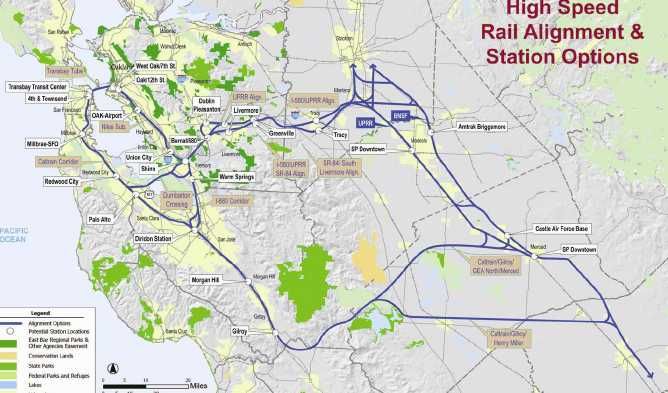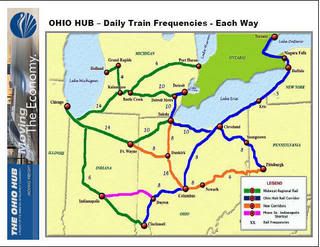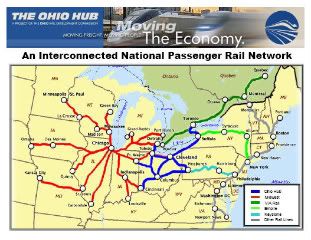(10 pm. “This is a great essay.” – promoted by ek hornbeck)
 Excerpted from Burning the Midnight Oil for Living Energy Independence (8 August 2008), in the Burning the Midnight Oil blog-within-a-blog, hosted by the EENR
Excerpted from Burning the Midnight Oil for Living Energy Independence (8 August 2008), in the Burning the Midnight Oil blog-within-a-blog, hosted by the EENR
Would California have HSR today if it had been settled by France? That’s what Michael Mahoney argued last Friday in the SFGate Open Forum.
The French, according to Mr. Mahoney, have a straightforward approach. The High Speed Rail train leaves the city on regular tracks running like an ordinary interurban express. When it gets out into the countryside, the HSR tracks start and it kicks up to full speed … 220mph and over, depending on the specific train. Then when it gets to into the urban area of its destination, it switches to regular tracks and back to running like an interurban express.
Most of the route is through the countryside, and that’s where its cheapest to build … both directly, and in terms of cutting down on the cost of overpasses.
SO … what did they do in California?
Well, I don’t live in California, so I will let Mr. Mahoney give his version of the story (however, there is a follow-up at the tail end of the essay):
If we in California were to build our train the European way, it would start in San Francisco and travel at normal speed to San Jose, then over the mountains into the Central Valley, where the high-speed line would begin. The train would run on that line near Interstate 5, though not right next to it, down the west side of the valley to Los Angeles. Once near the Los Angeles area, it would slow down and return to the normal train tracks.
If that idea had been adopted, the rail system could have been built by now. Unfortunately, the Central Valley politicians asked that the system serve the communities of Merced, Fresno, and Bakersfield, so Merced residents would have a high- speed train as well. An airliner from San Francisco to Los Angeles does not stop in Merced.
Seems like the Central Valley politicians got their way, and so the line is to go through the most heavily settled parts of the Central Valley, with an increase in cost and difficulty in putting the line through, including, of course, more overpasses … because true High Speed Rail needs full grade separation.

 Does California need true HSR at all? Can’t it get by with the “Express” speed tilt trains that are proposed in various parts of the country, like the Ohio Hub?
Does California need true HSR at all? Can’t it get by with the “Express” speed tilt trains that are proposed in various parts of the country, like the Ohio Hub?
Well, yes, California does need true HSR. 110mph tilt trains can provide a substantial improvement in rail services within Southern California and Northern California … but LA and San Francisco are just too far apart from each other to allow a tilt-train to complete the journey in under 3 hours. And finishing the journey in under 3 hours is key to the train taking substantial market share from air travel.
But … what about the Central Valley? Bakersfield is less than 300 miles, line of sight, to San Francisco, about 100 miles, line of sight, to LA. Merced is the reverse.
Now, because those stops slow down the HSR, the plan is for the HSR to include Express and Local routes, with the locals leaving the HSR line for the local stops, and the Express zooming on through.
But then … if the Central Valley “local” HSR were tilt trains on upgraded track in existing rights of way, they could, indeed, travel even faster on regular tracks when leaving San Francisco and LA than the HSR could, reducing travel time from Bakersfield to LA and Merced to San Francisco.
This is not just a California Principle
We can see opportunities to employ this same design principle all around the country. Indeed, if we look at the Northeast, there should certainly be a true HSR line between New York and Chicago. But that does not mean that the true HSR line should be pursued instead of the Ohio Hub. Rather, it would provide a strong complement to the Ohio Hub.
 Rather, it means that at the cost of one or two stops, connecting onto the Ohio Hub (probably SE Cleveland on the Cleveland/Pittsburgh route and north of North Central Ohio on the CCC route), all of Ohio can be claimed to be connected to Chicago and New York by a “modern, high speed rail network” … even though only one line has services operating at the modern 220mph+ speeds, and the rest are 110mph tilt trains.
Rather, it means that at the cost of one or two stops, connecting onto the Ohio Hub (probably SE Cleveland on the Cleveland/Pittsburgh route and north of North Central Ohio on the CCC route), all of Ohio can be claimed to be connected to Chicago and New York by a “modern, high speed rail network” … even though only one line has services operating at the modern 220mph+ speeds, and the rest are 110mph tilt trains.
And of course … everything in the western Great Lakes connects to everything else at Chicago. If there is a system to get the “Express” HSR routes in place, then its a matter of working out when enough benefit has been obtained from the dedicated 220mph track, and when to switch to running at regular speeds.
BFF: A Central Design Principle
Or, in other words, true full bore HSR and “Express” HSR are not rivals … they are potential partners.
And can we afford them? Well, given that we can run them on electricity generated by Wind Power and other renewable sources … while the same trick is much harder to do with the energy-intensive short airline routes that these are replacing … the question is rather whether we can afford not to.
Indeed, we can more easily afford both than we can afford either one alone. One size, yet again, does not fit all: each can do their task more efficiently than trying to make either one try to do everything at once.
And the Lesson for California?
California is facing a ballot initiative to fund a HSR system, with the chosen alignment, providing about 25% of the funding for the SF/LA core route, and then once those routes start returning on their investment, those funds are to be directed to expanding the system.
Now, California has some fairly weird geography, as far as passenger rail goes. The two biggest population centers are surrounded by terrain that is difficult for trains in general, including High Speed Rail. And the largest population center is Los Angeles, the poster-child for metropolitan sprawl development.
So, while Mr. Mahoney makes an argument that include some points that are valuable lessons for people considering establishing regional passenger rail systems elsewhere in the country …
Well, first, the idea about using regular rail systems to get through the city works much better for a city in the US Midwest than for Los Angeles … never mind the comparison to Paris or Marseille. And the rail network is much more focused to the needs of freight than to passenger rail, because of the US habit of subsidizing highways while telling railroads “You’re On Your Own”.
So for that actual California HSR system, it really is necessary to spend quite a bit on allowing HSR to run at high speeds through the sprawl that fills the LA basin.
And the Central Valley is not all that wide. Perhaps running down the western side could save thirty minutes … perhaps it could save ten minutes. But whatever the saving, there is little prospect that turning down the present, workable, system will result in it being quickly replaced by an even better system … it is far more likely to be a matter of back to the drawing board and a decade or more delay.
All of which suggests that Mr. Mahoney is not offering his suggestions in a serious hope of improving the California system … rather, it appears far more likely that Mr. Mahoney is doing what he can to de-rail the effort.
So if you are in favor of offering Americans the opportunity to travel in a much more energy efficient way today, with the further opportunity of running that system on sustainable, renewable electricity in the near term future … by all means support Prop 1.
However, for those of us living outside of California, we need to bear in mind the opportunity to mix regular, Express and Very High Speed passenger rail to form a route matrix that offers the best possible travel bang for our public transport buck.
| Midnight Oil – Truganini (1993) |
There’s a road train going nowhere Roads are cut, lines are down We’ll be staying at the Roma bar Till that monsoon passes on The backbone of this country’s broken |

5 comments
Skip to comment form
Author
… the future off track … it might help lead the way in getting the future back on track.
But that’s still up in the air … there’s a fight ahead on that issue this fall.
for trains! Why the U.S. is not forward-looking (and it isn’t, in so many, many ways) I do not understand.
What ek said: great stuff. Thanks.